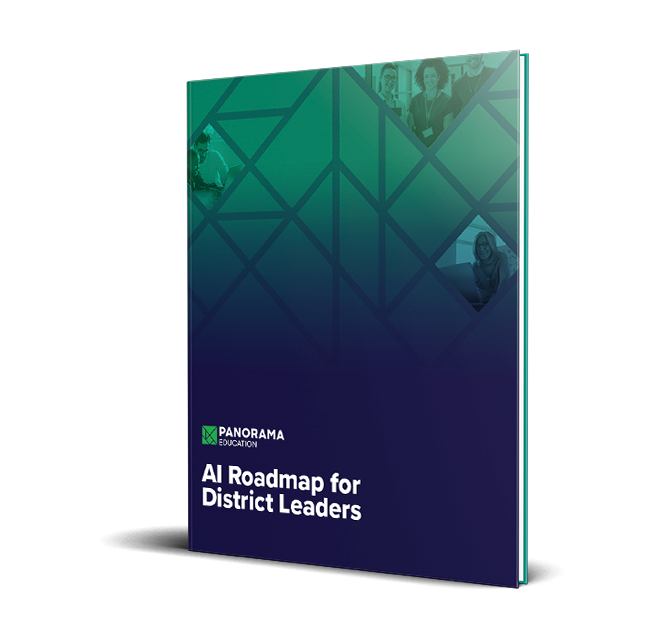When ChatGPT launched in late 2022, it sparked important conversations about the potential and challenges of this groundbreaking technology. Over the last few years, educators have increasingly explored how generative AI can shape learning and enhance the school environment.
Half of teachers use generative AI-powered tools like ChatGPT at least once a week for tasks like grading, lesson planning, and creating quizzes and assignments. Even more impressive, 77% of educators think AI is helpful, according to data from Carnegie Learning. But many districts are still finding their footing in response to the AI boom, working to expand professional development opportunities and establish clear AI policies.
By thoughtfully integrating generative AI, schools can enhance personalized learning experiences, streamline administrative tasks, and foster innovation in classrooms while aligning with their communities' needs and priorities.
Download Your Toolkit for Implementing AI in Schools
What is Generative AI?
Generative AI, or GenAI, refers to artificial intelligence models capable of producing new content, such as text, images, and even lesson plans, based on the data they are trained on. Artificial intelligence itself is not new—in fact, AI can be traced back to the mid-20th century. But this type of AI is groundbreaking in comparison to earlier artificial intelligence tools.
Precursors to generative AI, like predictive AI, function by analyzing data to identify patterns, make predictions, or suggest outcomes. These forms of AI rely on predefined rules and logic, making them more rigid and less adaptive. However, they set the stage for the data-driven and self-learning AI models we see today.
Consider this: while predictive AI could suggest which movie to watch next, generative AI can now create a movie poster, soundtrack, or even the film itself.
Use Cases for Generative AI in Education
The goals of education are deeply human: to foster critical thinking, creativity, and life skills. That leads many educators to wonder: How does AI fit in?
In a field where teachers go above and beyond and schools strive to do more with limited resources, generative AI has the potential to transform how teachers teach, students learn, and administrators make decisions. Here are some examples of how AI can be used in K-12 settings:
- Teaching Materials: Use AI tools to craft lesson plans, quizzes, and worksheets aligned with curriculum standards or learning objectives.
- Personalizing Learning: Get recommendations for activities or resources based on individual student needs.
- Data Insights: AI can analyze attendance, performance, and engagement data to help educators identify trends and areas for intervention.
- Intervention Recommendations: AI can create personalized intervention strategies and plans based on students’ academic, attendance, and behavioral data to help educators deliver targeted support.
- Family Engagement and Communication: AI can help teachers generate attendance nudge letters for families and prepare for parent-teacher conferences.
Key Benefits of Generative AI for K-12 Education
For Teachers
Using generative AI for teachers can streamline and enhance various aspects of their workday. It can automate repetitive tasks such as drafting attendance or lesson plans. Teachers can use the tool to brainstorm classroom activities or customize plans for differentiated instruction.
AI-driven tools can help teachers analyze student progress more effectively and enable them to refine their instructional strategies with data-driven insights. It can even offer real-time feedback for student assignments so teachers can respond more effectively to individual needs.
For Students
AI-powered platforms can adapt instruction to different learning styles and paces so that every student receives tailored support to help them succeed. Students can benefit from individualized practice activities or AI-suggested resources that match their unique abilities.
Additionally, generative AI provides tools that enhance accessibility and inclusivity. Features like language translation and speech-to-text technology help bridge gaps for multilingual learners and students with disabilities, making education more equitable and supportive for all.
For Administrators
Generative AI offers powerful tools to help administrators make informed decisions to address challenges proactively. By analyzing patterns in student performance, attendance, and engagement, AI can provide actionable insights to guide strategic planning and improve outcomes.
These data-driven approaches empower schools to allocate resources, like staff and budget, where they are needed most. With more efficient processes, districts can focus on delivering the best possible educational experience for students.
Challenges and Considerations
With the advent of generative AI, many educators have expressed concerns with the new technology’s role in the classroom.
Critical Thinking & Creativity
According to a late 2023 EdWeek survey, 19% teachers cited cheating as a reason why they don’t believe the technology should be used in schools. However, others have accepted student use of tools like ChatGPT and instead are focusing on innovative strategies to embrace AI’s potential to spark student creativity. Teachers have folded AI into their lesson plans as a way to help students brainstorm ideas, synthesize their points, and improve upon AI writing.
Data Privacy & Security
Data uploaded into most AI tools is used to train and refine the broader model, meaning that private information like student data is not actually private. School and district leaders must be sure that the AI tools they adopt follow AI security best practices to protect student data and comply with relevant laws and regulations.
Bias & Misinformation
Generative AI is trained on information created by fallible humans, so it too can make mistakes. With proper AI training, digital literacy, and critical thinking, users can determine which information is trustworthy and reliable.
Professional Development
EdWeek Research Center found that 58% of teachers had not received any training on AI, despite its growing presence in education. Fortunately, districts are gradually releasing guidance on AI use and training educators (and students!) on AI literacy.
How District Leaders Can Start Implementing Generative AI
Adopting a district-wide AI strategy is an important first step toward enhancing your district’s learning environment. But districts must also support implementation of these tools to ensure their effective integration into classrooms. District leaders should consider the following steps to empower educators to use AI tools wisely.
Assess District Readiness: Evaluate your district’s infrastructure, policies, and staff readiness to adopt AI tools.
Partner with Trusted AI Providers: Look for solutions that comply with SOC 2 data security and governance standards and the Family Educational Rights and Privacy Act (FERPA). With Panorama Solara, educators can access a secure chat interface with education best practices and district-specific customizations. Using pre-built prompts, they can create personalized student supports—like intervention plans and family letters—faster and more efficiently.
Engage Stakeholders: Get students, parents, and staff involved early on to address any concerns, and implement a phased roll-out.
Offer Professional Development: Offer targeted training sessions aimed to equip educators with a deep understanding of AI concepts, the ability to evaluate AI tools, and the confidence to seamlessly incorporate them into both teaching and administrative practices.
Continually Gather Feedback: Implement a comprehensive system for monitoring and evaluating the effects of AI tools in your district. Regular assessments, coupled with feedback from educators, pave the way for data-informed decisions that refine and optimize the use of AI in the district.
Next Steps for District Leaders
Generative AI holds immense potential to reshape K-12 education by empowering teachers, supporting diverse learners, and enabling data-driven decision-making. However, its successful implementation requires a thoughtful, ethical, and collaborative approach. By addressing challenges and engaging all stakeholders, school and district leaders can harness generative AI’s transformative power responsibly.
Panorama Solara makes student support easier with secure AI that’s customizable to your district’s goals and practices. It’s the only purpose-built AI solution for K-12 districts, with best-in-class security.






